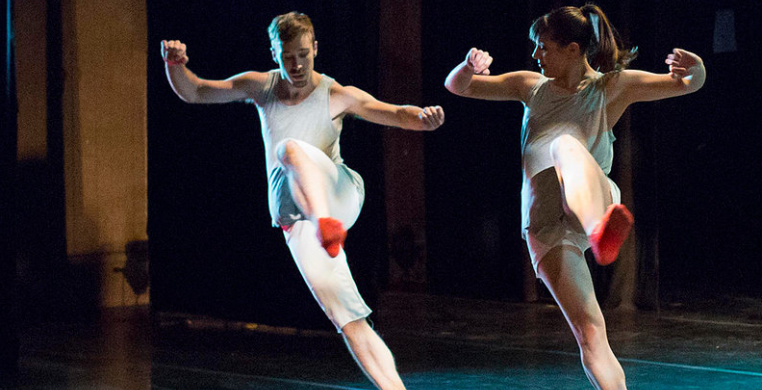Cerqua Rivera artistic director Wilfredo Rivera’s Recuerdos - Para Mi Familia (premiere) captures the essence of what this collaboration of dancers, musicians, and visual artists does best, but not nearly enough as yet. With a versatile ensemble of eight outstanding musicians on stage and savvy projection design technicians, the company is poised to pioneer something very special.
The first section of Recuerdos, “Tres Palabras - Mi Gente,” opens with a sculptural montage of dancers in versions of black street clothes. The mournful sound of a solo clarinet activates the cluster of male and female dancers, revealing the source of the music at their center, a lone clarinetist costumed in black bowler hat and suit. With the musician in the lead as a kind of musical narrator, the group forms what seems like a funeral procession, while a contrasting group of women in filmy aqua-blue dresses provides an ethereal Greek chorus of libation bearers. Rivera sets the two groups in counterpoint to each other in his deft use of divided stage space, rhythmic and dynamic contrasts, and differentiating movement patterns that engage the eye and sustain thematic interest. Intermittently, the two groups merge, blend, and separate, layering choreographic design and building thematic momentum.
Gradually, the clarinetist retreats to an upstage center spotlight, where he is still visually prominent but no longer integrated into the choreography. His retreat robs the piece of a unique, if choreographically challenging, opportunity to sustain the interplay between sound, musician, movement, and dancers.
The dancing, characterized by whip-like movements of the arms in parallel spirals around the head, sudden sharp kicks, and gnarly spiral turns, has, initially, a Spanish flavor of fiery emotional eruptions, especially effective set to the haunting clarinet music, composed by Osvaldo Farres. This dissipates in the second section, “Mi Viejo - Con Mucho Carino Pa,” composed by Piero Benedictis. As instruments fill in with a modern jazz feel, the dancing veers off into alternate territory without fully developing the compelling scenario set up in the first section. The piece never revisits the theatrical intensity or thematic substance of “Tres Palabras.” Spanish lyrics to the vocals are projected on a giant upstage screen above the musicians. A translation would have been helpful.
The third section, “Amor Gitano,” introduces us to the marvelous Mike Levin on violin, his versatility with jazz, folk, and classical idioms a treat throughout the program, but it was not clear how each of these segments formed a whole. With such rich musical resources at his fingertips, one hopes that Rivera will consider further exploring the thematic and structural elements of Recuerdos.
A little bit of Broadway slipped in with dancers Connor Cornelius and Daniel Chenoweth performing Marc Macaranas’s Elastic Pash (premiere) a choreographic flirtation with love at the soda shoppe, neatly danced with plenty of mime-esque gesture and vintage swing dance moves.
Raphaelle Ziemba’s In The Depths Of The Sensuous (2012) explores the weighty issue of sensuality and gender identity in a women’s trio, set to musical director Stu Greenspan’s thought-provoking arrangements. Providing the backdrop for a psychological study of body image as each of the three women contemplates the effect of undressing and dressing, the musical contrasts gave each solo a unique tone. In the first, cello and violin gave the dancer in blue a lyrical waltz for her to celebrate an “I feel pretty” moment. The second, with a strident 2/4 downbeat, gave the dancer in red a more aggressive response, while the woman in beige found her center in the Appalachian folk naturalism of banjo and whistling. The arc of discovery comes full circle when, at the conclusion, the women slide into their very different gowns and strap high heeled shoes onto bare feet, a pleasant surprise that brought audible chuckles from the audience.
Throughout the one-hour program, we were treated to a collection of paintings, photographs, and video footage projected onto the upstage screen. While the art, attributed to Shari Imbo, served as colorful backdrops to the dancing and had much in it to admire, it was unclear what impact it was intended to have on the choreography.
The dancers are a competent, clean ensemble, not without a few shaky turns or balances here and there. There was, however, especially strong men’s work in Ziemba’s And It Rained An Omen (premiere).
As the evening progressed, a sameness of style dominated the choreography--interesting initially in sudden shifts of focus, undulating torso loops, novel port de bras variations, and facile spines--but this wore thin as much of the dancing remained on the same dynamic. Breaking the pattern was the hot, high-energy finale, an excerpt from Tom & Jerry (1997), which had the full company dancing all-out to Cerqua’s rather cool jazz; fun costumes, but not exceptional in its choreography or execution. The strength of the company at this juncture is not in its technical prowess but in its clear potential for paving creative collaborations on stage.
Lynn Colburn Shapiro

